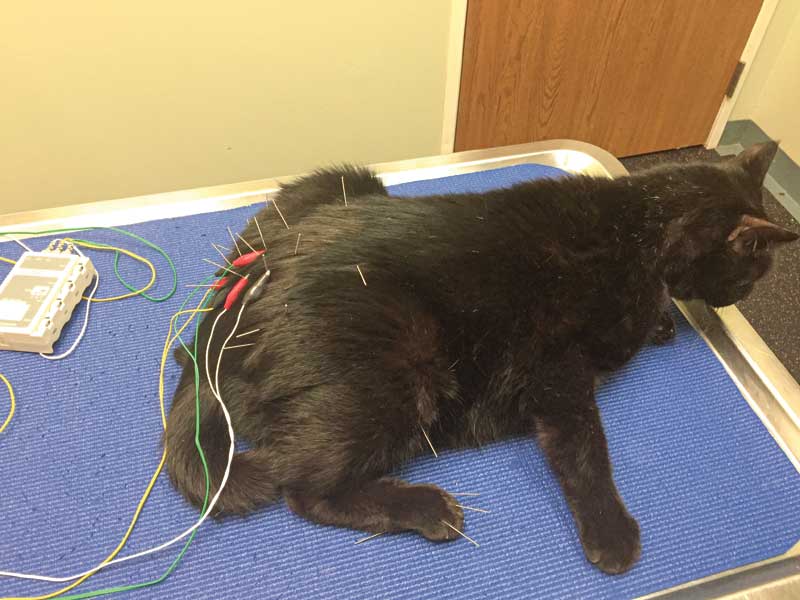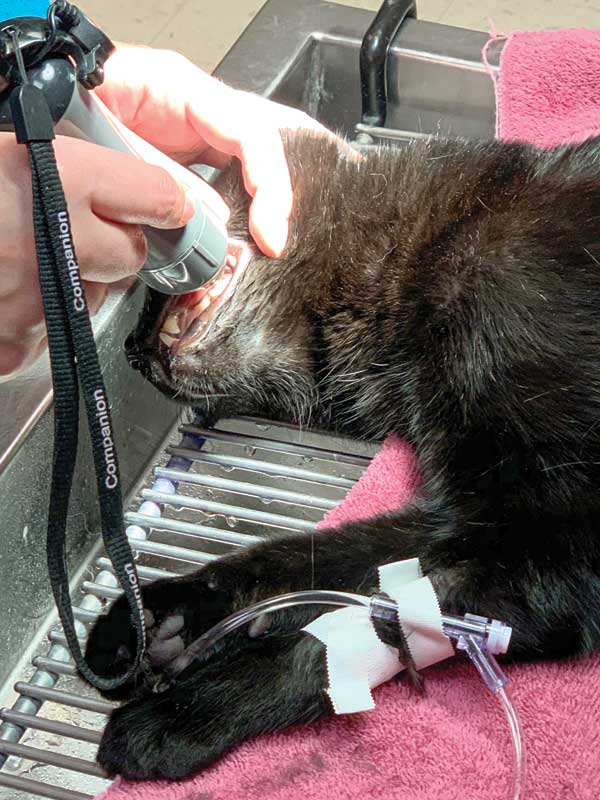Pain. It is not something we like to talk about. We might groan when we stand up, but our automatic response when asked how we are is to say we are fine, even if we are suffering aches and pains from our joints or GI system.
Patients “say” even less. Instinctively, they hide they are not feeling tip-top, nature warning them they are at risk from predators if they show the slightest sign of weakness, evolution not having caught up with the fact pets live in homes with loving families who would never want them to be in pain.
That silence can be a barrier to treatment. Clients may resist the idea their pet is in pain because they do not hear their dogs cry out or see their cats limp. “They’re just getting old,” they say. Those are the four most painful words a client can utter. Not because the phrase heralds recognition a pet is aging, but because it means clients may not realize their pet is in pain and could benefit from treatment.
For too long, the chronic pain of osteoarthritis or other diseases was simply accepted as a normal part of aging, especially for pets. Now, more is known about pain pathways and more options are available for managing pain multimodally, even over long periods. The one sticking point can be talking to clients about pet pain and demonstrating a pet’s slowdown is pain-related, not simply an artifact of aging for which nothing can be done.
Three veterinarians who target pain in their practices share tips on how to help clients recognize pain and get patients the help they need to improve their quality of life.
Make pain exams routine
Screening pets for pain should be part of every physical exam throughout the animal’s life, says Robin Downing, DVM, MS, DBe, DAAPM, DACVSMR, CVPP, Elite Fear Free Professional, hospital director of The Downing Center for Animal Pain Management in Windsor, CO. The more you put your hands on normal pets, the more readily you will recognize abnormal responses to palpation.
“There’s no better analogy than simple auscultation to pain palpation because it’s the same principle,” says Dr. Downing “When you have lots and lots of experience listening to hearts, your brain knows exactly what normal sounds like, which means abnormal jumps out.”
In “Managing Chronic Maladaptive Pain,”1 Downing describes how to perform a pain palpation suitable for dogs or cats using a technique grounded in palpation performed on people diagnosed with fibromyalgia. In a normal animal, the amount of pressure used will not elicit a pain response such as turning the head, moving away, flinching or vocalizing.
To aid owners in understanding what palpation is telling you, ask to demonstrate on their forearm with fingers or thumb the amount of pressure you are using. That allows them to feel for themselves the amount of pressure is innocuous, Downing says.
When she then touches the animal in the same way and the pet reacts, clients can see for themselves that something is not right. That opens the door to discussing the presence of pain and the importance of managing it.

Ask what clients are seeing
You may notice when the patient comes in their mobility is poor or they have changes in posture. Or the client care coordinator may note in the appointment the client mentioned the dog could no longer get in or out of the car by itself.
Before jumping into a discussion on the presence of pain, ask clients whether they have seen changes in the animal’s behavior: moving more slowly on walks, not wanting to go as far, not using the litter box, fighting with other animals in the house, not eating, or hiding under the bed. Discussing those changes is an opportunity to bring up how they can be related to pain.
A diagnosis of chronic pain due to osteoarthritis—which is highly prevalent in dogs2 and cats3—can come as a surprise to clients, says Tamara Grubb, DVM, PhD, DACVAA. Dr. Grubb uses the exam as an opportunity to show clients what pain looks like and evidence for the diagnosis of pain, including how behavior changes can be indicative of pain.
She might say: “I see some changes in your dog or cat that I didn’t see last time. That slowing down, that change in posture, the changes in behavior you just described to me can signal a lot of things, including pain.” Then you can go on to discuss what you’re seeing and explain why that can be evidence of pain.
It is not unusual for clients to attribute the behaviors to aging or, often in the case of cats, vindictiveness, says Michael Petty, DVM, CCRT, CVPP, and a diplomate of the American Academy of Pain Management. “He’s mad about something” or “He doesn’t like the other cat; that’s why he’s peeing outside the litterbox.”
A study4 published in February 2020 reviewed 100 dog cases and strongly suggested the potential role of pain in problem behavior. The veterinary behavior experts involved found, conservatively, around a third of referred cases involved some form of painful condition, and in some instances, the figure was nearly 80 percent. “Musculoskeletal but also painful gastrointestinal and dermatological conditions are commonly recognized as significant to the animal’s problem behavior,” they wrote.
Dr. Petty recalls an early case in which a dog was limping. “There was no doubt this dog had pain,” he says. After treatment, the owner commented the dog had always been aggressive with other dogs—growling, avoiding them, not wanting to interact with them—but he had changed and become more social.

“I think that’s something we don’t really consider, that these behavioral changes could have a basis in pain,” Petty says.” “We’re trying to treat pain with Prozac and it’s not working. The reason is because it’s pain, not attitude.”
Picture this
It is a cliché, but a picture really is worth a thousand words when it comes to showing clients why you think their pets might be
in pain.
Videos available online5 can help to demonstrate normal mobility versus that of an animal in pain. One for cats6 might show a normal cat jumping onto a table while a painful cat first jumps onto a chair and then onto the table.
For a follow-up appointment, ask clients to video their animals at home doing normal things, such as going up or down the stairs, going on a walk, or jumping on or off furniture. Then show them where their pet hesitated before jumping up or down, was reluctant to chase a toy, or did not move smoothly over an obstacle on the trail.
This is a good time to stress the effects of pain. When pain changes behavior, it can have a negative effect on the human-animal bond, as well as on the animal’s quality of life.
“Pain can cause them to have insomnia and anorexia,” Grubb says.
Downing explains to clients how injuries or pain in one part of the body—the rear limbs, for instance—change the biomechanics of the entire body, causing pain in seemingly unrelated areas, such as the upper torso. “I’m going to find pain in the upper thoracics in a dog that has hip dysplasia not because they have pathology in the upper thoracics, but because they’re not moving the way they should and because those spinal cord segments are talking to other spinal cord segments,” she says.

reduced the grade of gingivitis following dental prophylaxis and may be a useful
adjuvant procedure following dental prophylaxis. Photo courtesy Michael C. Petty, DVM
Ways to manage pain
Current pain management goes far beyond NSAIDs and includes anti-nerve growth factor (NGF) injections; grapiprant, which works at a different part of the pain pathway than other NSAIDs,7 potentially causing fewer adverse side effects; and new injectable compounds8,9 to treat the joint directly with long-lasting effects by targeting inflammation and pain or protecting and supporting the joint through biomaterials such as collagen and elastin.
“It’s not just about systemic medications; it’s also thinking about what we could do at a single joint to improve that joint health,” Grubb says. For clients on a budget, some inexpensive NSAID options exist. Gabapentin, utilized in appropriately high doses, can be a gamechanger for pets in pain, Downing says.
A retrospective study10 of 240 dogs looked at using gabapentin for chronic pain. “It is the first peer-reviewed paper in the veterinary literature that articulates effective doses of gabapentin in dogs with chronic pain. The balance we need to achieve is the balance between comfort and sedation, and sedation is the only relevant side effect. If we get sedation, we’ve gone a little too far in the dose, so we back it off, Downing says.”
Clients who have young animals diagnosed with chronic pain may be reluctant to start them on medication. Grubb tells them, “We’re not treating your dog’s age; we’re treating your dog’s pain.” She finds that once they understand how pain affects their pet, most people are willing to try something, even if it’s not medication.
Finally, pain management is always multimodal, Downing says. Do not just throw an NSAID at it and call it a day. Collaborate with the client to create a personalized pain plan appropriate for each patient, including follow-up visits and an ongoing dialog with the client. If particular patients exceed your ability to get them comfortable, do not hesitate to consult or refer to a pain specialist.
Kim Campbell Thornton has been writing about dogs, cats, wildlife, and marine life since 1985, and is a recipient of multiple awards for her articles and books from the Cat Writers Association, Dog Writers Association of America, and American Society of Journalists and Authors.
References
- Clinician’s Brief https://www.cliniciansbrief.com/article/managing-chronic-maladaptive-pain
- Wright A, et al. Identification of canine osteoarthritis using an owner-reported questionnaire and treatment monitoring using functional mobility tests. J Small Anim Pract, 2022
- Lascelles BD. Feline degenerative joint disease. Vet Surg. 2010 Jan;39(1):2-13
- Mills, DS, et al. Pain and Problem Behavior in Cats and Dogs. Animals, 2020 10(2), 318
- https://www.zoetispetcare.com/checklist/osteoarthritis-checklist
- https://www.zoetispetcare.com/checklist/osteoarthritis-checklist-cat
- Shaw, KK, Rausch-Derra, LC, Rhodes, L. Grapiprant: an EP4 prostaglandin receptor antagonist and novel therapy for pain and inflammation. Vet Med Sci. 2016 Feb; 2(1): 3-9
- Lattimer, J, Fabiani, M, Gaschen, L, Aulakh, K, Selting, K. Clinical effectiveness and safety of intraarticular administration of a 117m Tin radiocolloid (Synovetin OA) for treatment of early and intermediate grade osteoarthritis of the elbow in a dose finding study conducted in 44 dogs. Veterinary Radiology & Ultrasound. 12 December 2022.
- Stewart, S, Thomson, C, Kleeman, EB. Pilot study to evaluate the intra-articular injection of Spryng in dogs with stifle disease with initial product tolerance review. Ethos. Completed September 2023.
- Davis, LV, Hellyer, PW, Downing, RA, Kogan, LR. Retrospective Study of 240 Dogs Receiving Gabapentin for Chronic Pain Relief. Journal of Veterinary Medicine and Research. 13 August 2020.

